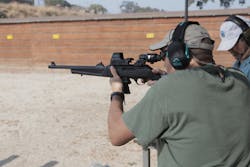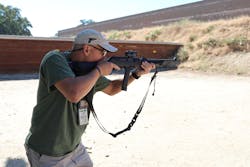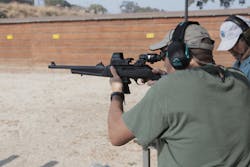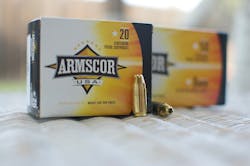Test & Evaluation: Ruger PC Carbine
The Ruger PC Carbine, semiautomatic carbine, can be fed with commonly acquired Ruger and Glock magazines. It was not hard in this month’s testing to determine that this firearm is ready to be sworn in at any time.
The Ruger PC Carbine has a receiver made of CNC milled aerospace grade 7075 T6 aluminum. The receiver has an integrated rail with a hard coat anodized finish. The cold hammer-forged chrome moly 16.12 inch barrel has a 1:10 right-hand twist. The barrel comes with a 1/2”-28 thread, with an included thread protector.
The gun is fairly lightweight at 6.8 pounds. It comes standard with a glass filled nylon synthetic stock, which includes a forward accessory rail. The stock came with a spacer kit for precision fitting.
When discussing the purpose of a police carbine with one of the members of my testing team, he asked me why I was so excited about this gun. Anyone who has been around me enough probably has heard this ad nauseam—the purpose of the police carbine is to bridge the gap between the handgun and the precision rifle. It is something that every patrol car, and most other specialty assignment vehicles, should have.
The Ruger PC Carbine takes magazines common to the largest percentage of agencies in the world. It feeds a common cartridge and a common magazine without modification. It accepts common optics and accessories.
When I finished the testing, I determined that it was simple to maintain, highly maneuverable and shares almost the exact manual of arms as the most familiar .22 caliber semi-automatic carbine in the industry.
Let’s get into the details
The sub-caliber trainer for the Ruger PC Carbine, the Ruger 10/22, has been continuously in production since 1964. I would venture to guess almost every gun owning household has one, which means that most of us can pick up a Ruger PC Carbine and operate it nearly blindfolded.
Once adopted by an agency, the Ruger PC Carbine gives all of the officers in that agency license to go out and get themselves a 10/22 so they have a sub-caliber trainer. There now, I’ve said it.Gene Whisenand of Trident Firearms Academy and I had shot his Ruger PC carbine long before we received a test gun from Ruger. This gave us an opportunity to compare them for consistency in manufacture. Gene’s carbine was equipped with a Spectre sling, which keeps the carbine close to the body during gun transitions. We also experimented with different approaches. You see, Gene is a right-handed shooter, but he had switched the charging handle to the left-hand side. I think I will, too. It allows the gun to remain on target, on shoulder, when manipulating the charging handle.
We tried the charging handle on both sides. Unlike several similar designs, keeping the charging handle on the support side seems to work better. If this gun is going in the patrol car, having the charging handle on the support hand side would allow the gun to be in the rack without a round in the chamber. The PC Carbine also has a cross-bolt safety that is easy to confirm by feel.
Ruger uses a tungsten weight on the bolt—their dead blow action. If the bolt is heavy enough, it really doesn’t take much to delay opening the chamber with just the weight of the bolt and spring pressure for a 9mm. It has to be timed well, but the 9mm allows for a very simple design.
The dead blow action shortens the bolt travel. This reduces both the recoil and the field of the gun when the bolt travels back in the battery. It is a machined, heat treated, chrome moly steel bolt.
Like the Ruger 10/22, the design of the PC Carbine is very simple, and straight-line bolt travel doesn’t call for a lot of moving parts or surfaces that will readily wear. Not only does this simplify maintenance, it also is an inherently sturdy design where surface erosion from long use is greatly reduced.
I cannot emphasize the shortness of the bolt travel and the lack of muzzle rise, even with +P rounds. Gene and I did a slo-mo video of my shooting the PC Carbine while moving in order to evaluate its handling characteristics. You can check out the video here.
The recoil sensation
I shot the gun before I disassembled it, which is totally out of character for me. I usually want to look under the hood and see what makes the thing tick. The first time I pulled the trigger, I was quite surprised. It felt like there was something missing in the recoil, sort of like a little rebound in the bolt when it chambered. It reminded me of the “buffer feel” when shooting a M-16. Of course, the bolt doesn’t exactly rebound, it’s just the quick short stroke of the action.
The PC Carbine flowed easily from shot to shot, with a balance that allowed it to quickly settle on the next target. If I was in a really bad situation where I had to engage multiple targets in a short amount of time, I believe I would be faster with the PC Carbine than an AR-15. Although it is perfectly capable of longer range shots, the PC Carbine is definitely the king of distances that are statistically police engagement ranges.
For a working carbine, the trigger is crisp with limited overtravel.
Testing with ammunition
We used Armscor 9mm ammunition throughout the test. I personally like the 124 grain 9mm cartridge, and Armscor makes a JHP duty round and a FMJ practice round in 124 grain. Both cartridges performed almost identically, including the fact that they group in the same place with the same accuracy.
Law enforcement agencies must consider cartridge selection for the PC carefully. Out of a 4” barrel handgun, one can usually expect around 1,225 fps for a 124 grain +P cartridge. The Armscor 124 grain JHP rounds were slightly hot, running nearly 1,300 fps out of my short-barreled Kahr. In the Ruger PC Carbine, they screamed out of the barrel at 1,535 fps.
First of all, this is fantastic performance for both the Armscor cartridges and the Ruger PC Carbine. However, bullets designed for specific purposes sometimes do not do well for others.
Agencies should do some testing with the duty cartridges before they try to use the same cartridge in the carbine as they do for the handgun. Driving a bullet faster than its designed purpose can result in overexpansion and under penetration, separation of the bullet from the jacket, and over penetration.
Having said that, 1,535 fps is awesome for a duty carbine.
I did not do ballistic gelatin testing on the Armscor 124 grain JHP. That is definitely something on my radar, considering the outstanding performance Armscor cartridges delivered. Shooting the carbine offhand, I could get all of my rounds within an inch consistently. I did a few “move and shoot” exercises, and the Ruger PC Carbine felt natural while doing them.
Adding a reflex sight
We used a Sightmark Ultra Shot A-Spec Reflex Sight, combined with their XT-3 magnifier. I picked the Sightmark A-Spec because they are well suited for fast alignment.
The A-Spec is NVG compatible, IP55 weather resistant and gets an astronomical amount of battery life from a CR123 cell. I know that this is larger than using the coin cells, but the resulting daylight image does not get washed in direct sunlight.
The A-Spec is parallax corrected past 10 yards and offers unlimited eye relief. It has a really solid quick mount, which I tested for repeatability of settings. I paired my A-Spec with the XT-3 magnifier.
Disassembly and maintenance is simple, but it helped to have someone who shoots a PC Carbine regularly when taking it apart the first time. The barrel and receiver separate by clearing the gun, then locking the bolt to the rear, after looking into the chamber to check to see it is unloaded, then checking again. There is a recessed lever where the gun separates the barrel from the receiver. One pushes it and twists the parts apart. The PC Carbine is now packable.
There are two screws holding the base of the receiver to the stock. Once the receiver is free, unscrewing the charging handle and removing the captive spring allows removal of the bolt.
Switching from Ruger magazines to Glock magazines is just a matter of changing the spacers in the stock. I didn’t notice any difference between using either magazine.
Agencies who adopt this carbine have another bonus. When one bails out of the patrol car to engage, they often have whatever magazines on their belt to engage the threat. That is, if they grabbed their AR-15 on the fly, the chances of having an extra magazine is greatly reduced. With a PC Carbine, the magazines that go in the carbine are also the ones that go in the handgun. The officer likely has some reloads.
I hardly use this term, but the Ruger PC Carbine has definitely earned it—as a law enforcement tool, the Ruger PC Carbine is a game changer.
About the Author
A retired police officer and military small arms trainer, Lindsey Bertomen has taught shooting techniques for more than a decade, in addition to teaching criminal justice at Hartnell College in Salinas, California. Off the clock he enjoys competing in shooting sports, running and cycle events.
He welcomes comments at [email protected].
About the Author

Officer Lindsey Bertomen (ret.), Contributing Editor
Lindsey Bertomen is a retired police officer and retired military small arms trainer. He teaches criminal justice at Hartnell College in Salinas, California, where serves as a POST administrator and firearms instructor. He also teaches civilian firearms classes, enjoys fly fishing, martial arts, and mountain biking. His articles have appeared in print and online for over two decades.




